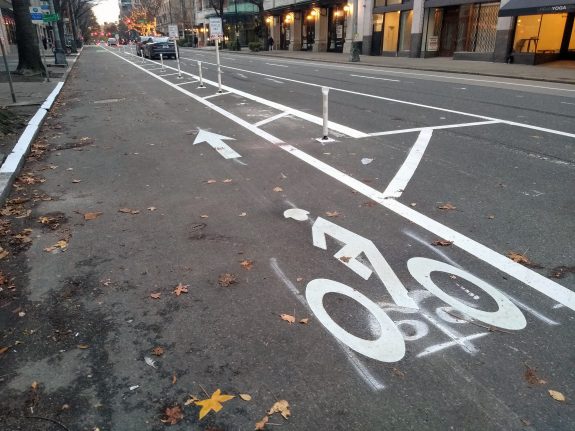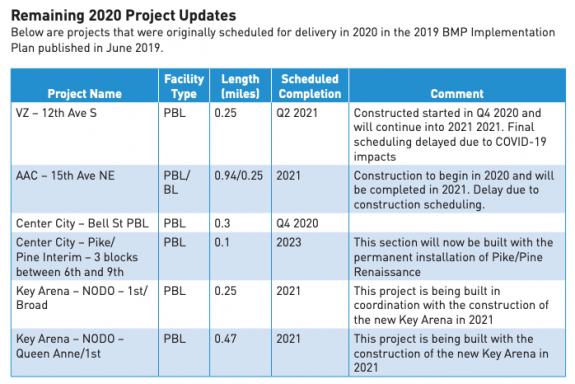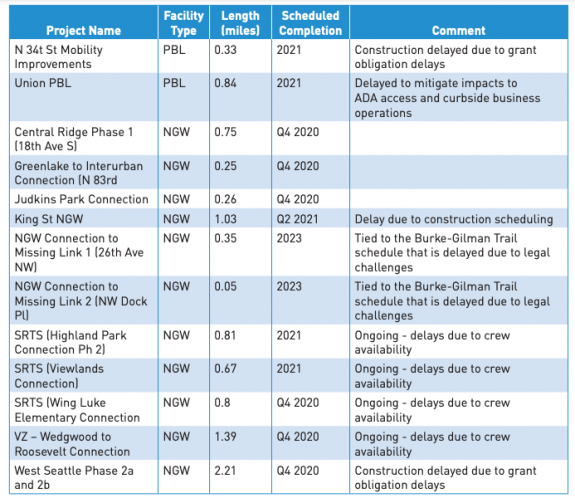A report completed by the Seattle Department of Transportation in December but not released until this week shows how much catching up the department is planning to do in 2021 to complete installing bike facilities that it had originally planned to install last year. This report is the most recent update on SDOT’s progress on building Seattle’s citywide bicycle network since the recalibration of the construction plan for the remainder of the Move Seattle levy through 2024 was completed in 2019.
According to the report, only 2.3 miles of protected bike lanes or neighborhood greenways were completed through the third quarter of 2020, compared to the original plan for the year of 15.2 miles set in 2019. The ones that were installed were almost all big achievements, it must be noted. These were the Avalon Way PBL in West Seattle. the first phase of the 4th Ave PBL downtown, a Yesler Way PBL between 12th and 14th Ave, and a neighborhood greenway on Capitol Hill connecting Lowell Elementary School and Meany Middle School. SDOT is also counting the Lander Street Overpass as bicycle infrastructure in the report, which certainly makes it the most expensive trail constructed in Seattle at $100 million for one quarter mile.
Another 6 miles of PBLs and greenways were scheduled to be completed by the end of the year, but the majority of those projects didn’t achieve that deadline and were pushed into 2021. One project, the completion of the Pike Street protected bike lane between 6th and 9th Ave downtown, was essentially cancelled after originally being scheduled for last year. It’s now only scheduled to be completed with the rest of the permanent Pike and Pine PBLs installed as part of the Pike/Pine Renaissance in 2023.

That means SDOT is planning to complete around 11 miles of neighborhood greenways or protected bike lanes this year that were originally planned for last year, on top of what was originally scheduled for 2021. In an assessment of the impact of the Covid-19 crisis on the entire department published this year, SDOT said they were on track to complete 50-55 miles of bike facilities, including painted bike lanes, by the end of the levy in 2024. This is half of what was promised to voters in 2015.
We don’t yet know what impact the delay in project delivery in 2020 will have on projects scheduled for 2021 and beyond. Traditionally, every spring the Bicycle Master Plan’s implementation schedule would be reviewed by the city council’s transportation committee, something that didn’t happen in 2020 due to the Covid emergency. It’s also not clear that reviewing the bicycle master plan’s implementation is a priority of Alex Pedersen’s transportation committee.
Below is the list of 2020 projects that are set to be (mostly) completed in 2021 or later.


Hopefully we can get a more complete picture on the status of the program before too many additional months of 2021 progress. You can read the full 2020 status report report here.








Comments
8 responses to “Report details how much catching up Seattle has to do in 2021 on bike lanes”
There sure weren’t any delays in building the Lander Street Overpass with Move Seattle money! No trouble getting that done!
Actually the Lander overpass took over 20 years to complete. It was delayed for over ten years by having funding in the Bridging the Gap Levy that SDOT was planning on using for its construction diverted for the Mercer Street rebuild when that levy ran short of the funds needed to complete all of the promised projects.
Not to disagree with your larger point which is that far more money is readily available for road projects than bike and pedestrian infrastructure.
I think a major factor in the delays is political. Especially during our year of restrictions, traffic has been lighter and a much higher percentage of people driving than taking public transpo. The pushback on removing traffic lanes is higher than before, and it certainly hasn’t been a “quiet” aspect in the past.
To overcome this pushback, I think we are going to have to provide solutions that give higher priority to traffic lanes. In neighborhood arterials, this might be done by eliminating parking on the arterial. That likely needs to be replaced with additional parking off the arterial. Then there would be room for bikes *and* cars.
I know that sounds counter to pushing for more biking, but I think it’s a reality. For example, in London, many neighborhoods have no parking along the “high” street. However, there’s huge parking just behind or under some of the major shopping areas. Many people walk, but driving is almost as popular there as it is here. They just deal with it differently.
I don’t think the pandemic has increased backlash to bike lanes. Stay Healthy streets certainly didn’t have trouble getting approved. If anything, less traffic overall means less need for car capacity and many people avoiding public transport are switching to biking instead of driving.
As an example, I ride over the 520 bridge regularly and the bike counters are just as high as they were pre-pandemic, even while car traffic across the bridge is way down with Microsoft and other offices shuttered.
You may be right, but I don’t think Stay Healthy Streets are a fair comparison to arterials. Regardless, there is fierce pushback, whether its different now than before the pandemic.
Sure, there’s always been backlash. But I haven’t seen any evidence of COVID making it worse than it always has been.
Removing parking was the plan on 35th Ave NE. That didn’t go down very well
https://waterfrontseattle.blob.core.windows.net/media/Default/pdf/2020_0507_SeattleDesignCommission_%20PikePine30Presentation.pdf Should the Pike Pine Renaissance be assumed or rather questioned and revised? Does it depend on WSCC funding; is it in trouble? The plans look like a pair of one-way couplets with bikes and transit each sharing Pike and Pine streets. Most of the civil work would widen sidewalks. SDOT and the community just went through a nice workshop on Pike Street that seemed headed toward two one-way cycle tracks on Pike Street. Would not transit be better off with two-way service on Pine Street to minimize distance from Link? Would not bikes be better off with two one-way facilities on Pike Street? A transit emphasis was suggested in the late 1980s by Councilmember Benson. The I-5 oriented routes on Pike Street will probably be changed in fall 2021 with Northgate Link. The PPR seems to assume the CCC Streetcar that appears less and less likely.